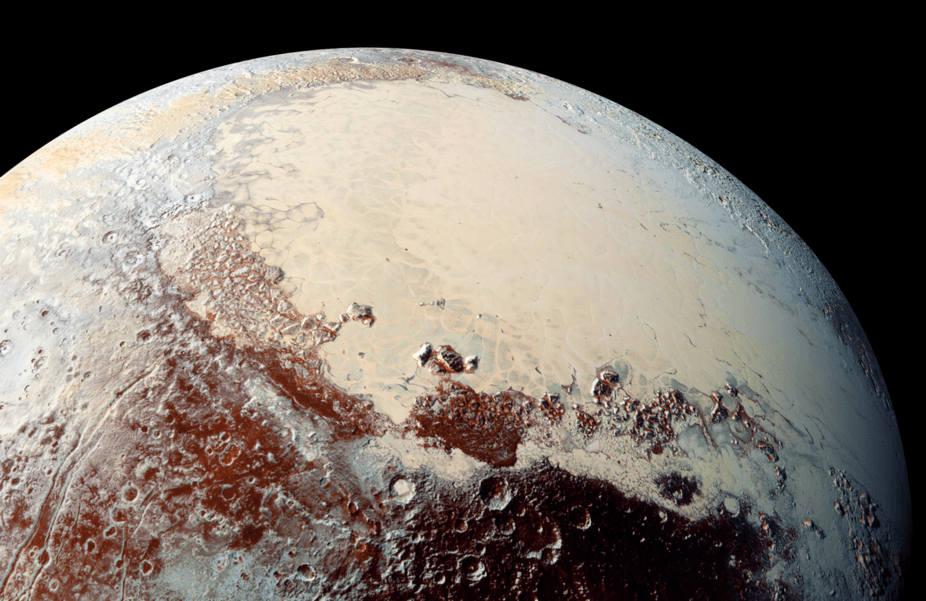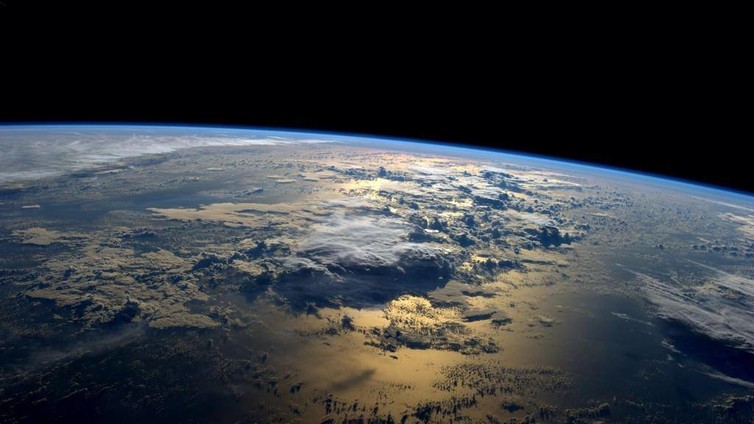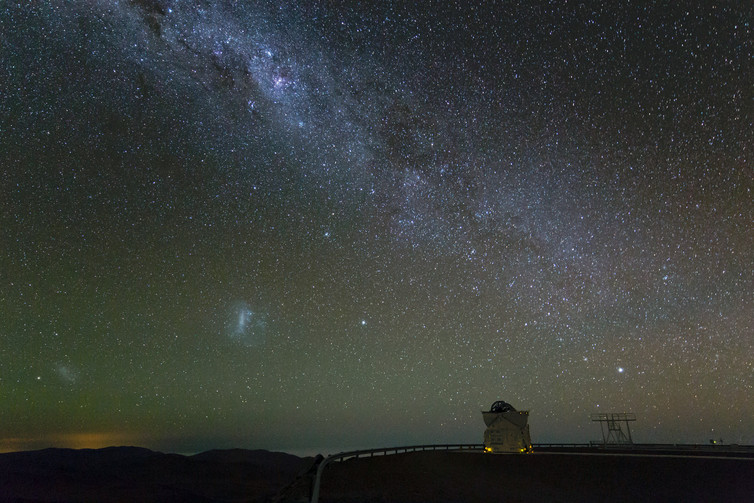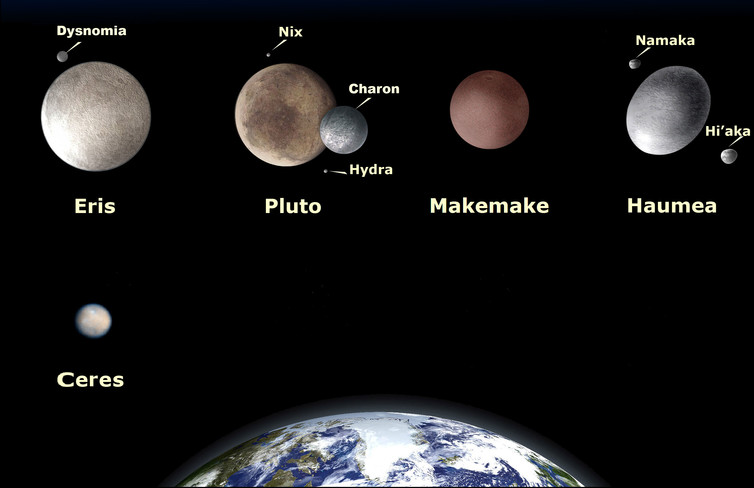
Planet or Dwarf Planet: All Worlds are Worth Investigating

This article was originally published at The Conversation. The publication contributed the article to Space.com's Expert Voices: Op-Ed & Insights.
Pluto's status as a "dwarf planet" is once again stirring debate. This comes as some planetary scientists are trying to have Pluto reclassified as a planet – a wish that's not likely to come true.
Pluto has been known as a dwarf planet for more than a decade. Back in August 2006 astronomers voted to shake up the Solar System, and the number of planets dropped from nine to eight. Pluto was the one cast aside.
There was some outcry that Pluto had been destroyed in an instant and was no longer important, and the reverberations were most keenly felt across America.
After all, Pluto was "their planet," discovered in 1930 through the meticulous observations of American astronomer Clyde Tombaugh at the Lowell Observatory in Arizona.
At the time of the vote, NASA's New Horizons spacecraft was only seven months into its nine-year journey to Pluto. There was concern that when it finally arrived, would people even care about a dwarf planet?
For many astronomers, the demotion of Pluto was a defining moment. It wasn't a gesture of destruction and it wasn't aimed specifically at Pluto. What it signalled was a major leap forward.
Get the Space.com Newsletter
Breaking space news, the latest updates on rocket launches, skywatching events and more!
In that moment the world's astronomers acknowledged significant progress in our understanding of the Solar System, an achievement to be proud of – even if everyone was not entirely happy.
What's in a name?
The first step to understanding a group of objects is to classify them. We group like with like to examine the aligned characteristics or any significant differences between groups. With this insight comes a deeper understanding of how things work, form or evolve.
The planets were originally grouped together because the ancient Greeks saw them as "the wanderers," travelling across the sky. Five bright objects – Mercury, Venus, Mars, Jupiter and Saturn – may have looked like stars, but while stars stayed fixed within their constellations, these planets moved independently from them.
The cause of this planetary motion was eventually established by the Polish astronomer Nicolaus Copernicus in the 16th century, bringing with it a new revelation. Planets were more than wanderers, they were objects in orbit about the Sun and with this understanding Earth became a planet too.

Defining a planet in the 21st century
More than 400 years and many discoveries later, a new storm began brewing in our understanding of the Solar System.
Since 1992, astronomers had begun to find objects orbiting the Sun out in the realm of Pluto. Were they planets too?
Conversely, Pluto was a bit of an oddball. It was smaller than several moons of other planets, and it had a highly inclined orbit that made it stand out from the others. Was it truly a planet or was it part of a much larger family of objects?
With the discovery of Eris (originally known by its designation 2003 UB313) in 2003, a decision could no longer be avoided. Eris was about the size of Pluto and certainly more massive. Was Eris a planet? And if not, where did that leave Pluto?
Astronomers have a forum for such deliberations via the International Astronomical Union (IAU). Representing astronomers worldwide, the IAU is the recognised authority responsible for naming and classifying planetary bodies and their satellites.
The IAU formed a Planet Definition Committee to consider the scientific, cultural and historical issues at hand. A draft proposal was put forward, and during the 2006 IAU General Assembly in Prague, with the world's astronomers gathered together, the Committee's proposal was vigorously debated.
A revised proposal was presented to the IAU membership on the final day of the General Assembly and was passed with a large majority.
For the first time, a planet was formally recognised as being "a celestial body that:"
(a) is in orbit around the Sun
Since Pluto had not "cleared the neighbourhood around its orbit," it was not a planet but would be recognised as a "dwarf planet."
A colleague of mine, Martin George, director of the Launceston Planetarium, was there when the vote was taken and captured the excitement and the nuance of the event.
There was quite a buzz in the room and we knew we were about to make history. Did everyone agree on the exact wording? Perhaps not. However, I think it would have been worse to see media headlines reading 'Astronomers cannot decide what a planet is.'
Size matters and location too
The distinction of planet and dwarf planet brings a consistency to how objects are named across the universe. On the grand scale, there are galaxies and there are dwarf galaxies.
Within our Milky Way Galaxy, the Sun is a yellow dwarf star that in billions of years will evolve to become a red giant before ending its life as a white dwarf.

These distinctions among galaxies and stars helps astronomers interpret and understand them, tracing their evolution.
Planets and dwarf planets are distinct because of their size and their location in the solar system. It provides a way to examine how planets and dwarf planets may have originated and evolved differently.
Planetary resemblance
At present, the IAU has officially recognised five dwarf planets. They are Pluto, Eris, Makemake and Haumea, which orbit the Sun beyond Neptune, and Ceres, which is the only object in the asteroid belt massive enough to be spherical.

Detractors and also supporters of the standing planet definition can point to problems with it. For instance, it only applies to objects orbiting the Sun. But what about exoplanets? And what is meant by "cleared its neighbourhood?" If Earth was located farther away from the Sun, would it be able to clear its orbit?
But, as astrophysicist Ethan Seigal explains, minor qualifications to the planet definition can bring it in line with exoplanets and allows the definition to work with renewed clarity.
Whereas the latest proposal to reinstate Pluto, advocates a geophysical definition of planet. Namely, that a planet should be large enough to be round, but not so big that it is a star. This broad definition casts the net wide, and not only Pluto, but also the Moon and more than 100 other Solar System objects would become planets.
Now wouldn't that be a leap backwards in regards to structuring and understanding our Solar System? How much of it is driven by the notion that nothing but a planet is worth exploration?
There's a plethora of "not-planets" in our Solar System that are worlds worthy of attention. This includes the fiery volcanoes of Io, the icy geysers of Enceladus, the reddish surface of Makemake, the crazy spin of Haumea and the mystery of hundreds of worlds unknown orbiting beyond Neptune.
So let the official word on planets and dwarf planets be as passed in 2006 and let our exploration of the Solar System continue to amaze us.
Tanya Hill, Honorary Fellow of the University of Melbourne and Senior Curator (Astronomy), Museum Victoria
This article was originally published on The Conversation. Read the original article. Follow all of the Expert Voices issues and debates — and become part of the discussion — on Facebook, Twitter and Google +. The views expressed are those of the author and do not necessarily reflect the views of the publisher. This version of the article was originally published on Space.com.
Join our Space Forums to keep talking space on the latest missions, night sky and more! And if you have a news tip, correction or comment, let us know at: community@space.com.

I am an extragalactic astronomer, Honorary Fellow of the University of Melbourne, and am currently working in the field of science communication at Melbourne Planetarium.
I have been the Curator (Astronomy) at Melbourne Planetarium, Scienceworks since 1999, drawing on my background in research astronomy to create more than a dozen planetarium productions. The most recent of these are now screened in over fifty planetariums across sixteen countries world-wide.
I am proud to be the Australian Representative of the European Southern Observatory’s (ESO) Science Outreach Network. This sees me working with Astronomy Australia Limited (AAL) to promote ESO’s extensive research accomplishments throughout Australia.
I am also involved in projects to bring research astronomy data into the planetarium to both engage the public and to turn the planetarium into a tool for research astronomers wanting to know more from their data.









